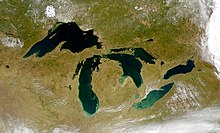On a recent trip from Denver to Grand Junction, Colorado, I once again marveled at the runaway truck ramps that dot I-70. Maybe it's because I grew up in the flatlands of Nebraska that I find these ramps so intriguing.
Colorado has 13 runaway truck ramps. Most of these ramps were built between the late 1970s to the early 1980s. I often wondered how frequently these were used. It wasn't until this last trip across the state that I actually saw a semi-truck near the top of a ramp. It was severely damaged and the ramp was closed for repairs. After I returned home and started this post I realized that where I saw the truck, on I-70 westbound from the Eisenhower Tunnel toward Silverthorne, is the ramp that gets 20 to 30 customers each year. It is the most used ramp in the state. The other 12 ramps get two or three vehicles annually.
 |
This is the first runaway truck ramp west of the Eisenhower Tunnel westbound on I-70.
Going up one of these ramps is a one way trip. In Colorado a driver using the ramp must pay for the tow out as well as the repair of the ramp.
There are many varieties of runaway truck ramps. These life saving ramps can be arrester beds, gravity escape ramps, sand pile escape ramps, mechanical-arrester ramps or a vehicle arresting barriers. The names suggest the method used to stop a runaway truck. If you'd like to read an overview about these various types of ramps I found a simple description on Wikipedia you might enjoy perusing. There is also a Facebook page on Runaway Truck Ramps with this information.
Truckers, RVs and motorhome drivers are given lots of warnings along I-70 about the need to travel with great care. Crash Forensics reports that three roadway concerns can contribute to the hazardous conditions of a road. Grade steepness is often what we think of first. Most of the steep grades along I-70 are at 7%, some at 6%. However, grade length and the curve severity also are factors not to be ignored. In the signs below you can see that CDOT has posted warnings with a little bit of humor to catch truck driver's attention.
|
The runaway truck ramps are built to stop a semi-truck that is carrying up to 80,000 pounds. If it's indeed a runaway truck it can be traveling up to 100 mph. If you see smoke around a truck's tires make sure you give the road to the trucker. The look of terror on his face and the icy grip he has on his steering wheel might be another indicator of trouble. Summer is the time when the runaway truck ramps are most used. The overheating of the breaks and increased traffic add to this count.
The Colorado Department of Transportation is trying to avoid accidents by directing the truckers onto runaway ramps rather than the more populated exits.
Many other states, besides Colorado, and countries too, have runaway truck ramps. Some are called emergency escape ramps, runaway truck lanes or truck arrester beds. The most used one in the world is in the state of Wyoming. It's U.S. Highway 16. There is a section on it the locals call "Dead Man's Curve." The Buffalo Bulletin published a write up on July 11, 2012 about this runaway truck ramp. It's an intriguing read if this interests you.
Traveling through the Rocky Mountains along I-70 is a delightful drive. The scenery is breathtaking and changing frequently. Whether you are looking for Buffaloes at Genesse Park or anticipating your drive through Eisenhower Tunnel, the bright yellow runaway truck ramp signs will keep you alert to the steep grades and curves on your trip. Enjoy the views but drive safely.
Below are a variety of the runaway truck ramp signs you'll see along I-70 in Colorado. You can enjoy the scenery as you travel through the pictures.
Below you'll see the raindrops on the windshield. The weather conditions can change quickly adding to dangerous road conditions for all vehicles.
May you never find yourself at the top of a runaway truck ramp. Safe travels.




















































